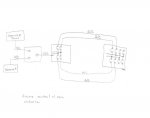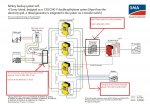TrickleCharge
Member
- Location
- CA
Hybrid System , PV, Battery, Generator, ATS Confused Designer? Parallel feeders &ocpd
Ok so I have a designer/contractor who is proposing this system with the ats, generator, pv, batteries, etc. Now the one thing that I have a question on is the "parallel feeds" that come from one panel to feed the sub panel. Basically these feeds go thru the (4) sunny island inverters via (4) 70A s.p. breakers to a sub panel which land on (4) 70A s.p breakers. Do you think that section 300.3 applies for parallel conductors which takes you to 310.4 for the requirements such as min 1/0 conductors etc? The colored diagram is a vague plan on how this will be done. The second hand written draft is showing the principal of parallel feeders. The other input that I gave the designer is compliance with 240.15 in regards to having the (4) single pole breakers feeding the sub panel. Thanks for the input.View attachment Wayne Dr 2.pdfView attachment Wayne Dr 1.pdf


View attachment Wayne Dr 1.pdf
View attachment Wayne Dr 2.pdf
Ok so I have a designer/contractor who is proposing this system with the ats, generator, pv, batteries, etc. Now the one thing that I have a question on is the "parallel feeds" that come from one panel to feed the sub panel. Basically these feeds go thru the (4) sunny island inverters via (4) 70A s.p. breakers to a sub panel which land on (4) 70A s.p breakers. Do you think that section 300.3 applies for parallel conductors which takes you to 310.4 for the requirements such as min 1/0 conductors etc? The colored diagram is a vague plan on how this will be done. The second hand written draft is showing the principal of parallel feeders. The other input that I gave the designer is compliance with 240.15 in regards to having the (4) single pole breakers feeding the sub panel. Thanks for the input.View attachment Wayne Dr 2.pdfView attachment Wayne Dr 1.pdf


View attachment Wayne Dr 1.pdf
View attachment Wayne Dr 2.pdf


